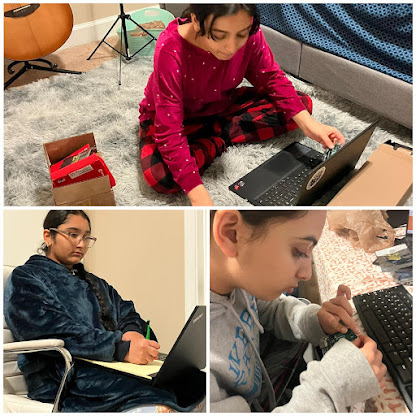STEM-In-Action Spring Scoop: NanoGenuity
Over the past year, our STEM-In-Action Grant-winning teams have been diligently advancing their eCYBERMISSION projects to create a meaningful impact in their communities. If you're new to the eCYBERMISSION blog, the Army Educational Outreach Program (AEOP) awards STEM-In-Action Grants of up to $5,000 to support teams looking to further develop and implement their initiatives. As we check in with this year's grant recipients, we’re excited to share updates on their progress. Today, we're checking in with NanoGenuity.
____________________________
We have been working on an ear piece that stimulates the vagus nerve to retain memory and keep cognitive health in check for people struggling with Alzheimer’s disease.
Since receiving the STEM-In-Action Grant, we have been working on finding products and helpful tools to help build our prototype. We have learned to find the right materials to work with and are currently finding new ways to keep on improving our prototype. Some real-time goals we are working on implementing are to:- Complete a functional prototype - finalize small touches and finish building the prototype.
- Test the device - this is to make sure the prototype is working properly.
- Improve the prototype with feedback- to implement more features that are convenient and expand community/ expert outreach, giving us connections in various areas.
Some problems that our team faces is not having proper time to build this prototype. We struggle with scheduling due to our busy schedules and extracurriculars . In the future, we hope to find more convenient times for both of us. Another problem is that we struggle with limited access to medical testing and proper validation. Because of this we cannot find the small mistakes in the prototype, limiting our ability to improve the overall product.
We have presented lectures and seminars in the library as part of our NanoGenuity project to inform the public about Alzheimer's disease, our research, and possible remedies. We have facilitated conversations on long-term care costs and social engagement with patients, caregivers, and neuroscience enthusiasts through these events. Awareness of the need for innovation in Alzheimer's care has grown as a result of our outreach. We participate in community activities, speak at senior centers and schools, and interact with local media sources to spread the word about NanoGenuity. We may possibly increase our audience and influence by contacting institutions, working with organizations, and leveraging social media.
So far, one of the most difficult tasks we have faced is making sure our approach is both financially feasible and scientifically sound for practical use. Much study, testing, and iteration are needed to create a wearable device that is both entertaining and useful while controlling the cost of components and materials. Since it has been challenging to balance our time between community service, prototype development, and academic obligations, being organized and focused is crucial. In spite of these obstacles, we have stayed dedicated to improving our strategy, consulting with professionals, and coming up with innovative methods to make most of the resources at our disposal.
Going ahead, our primary goal is to improve our prototype and see whether it could actually improve Alzheimer's care. We are eager to test NanoGenuity in practical settings, get input from medical experts and caretakers, and modify the technology in response to their conclusions. Additionally, we're excited to reach a wider audience, establish connections with additional subject-matter experts, and maybe work with groups or universities that have similar goals. Above all, we are thrilled about the prospect of providing a creative, cost-effective solution to those who need it most.
Our ideal outcome for this project would be to lay a strong foundation for a long term impact in the field of STEM. We want to set a clear roadmap for improving and expanding the device beyond the prototype. We would like to plan for further testing, refining the design, and possibly apply for patents or further research opportunities.





Comments
Post a Comment
We welcome your comments and expect that our conversation will follow the general rules of respectful civil discourse. This is a moderated blog, and we will only post comments from bloggers over 13 years of age that relate to eCYBERMISSION. We will review comments for posting within one business day. Bloggers are fully responsible for everything that they submit in their comments, and all posted comments are in the public domain. We do not discriminate against any views, but we reserve the right not to post comments.